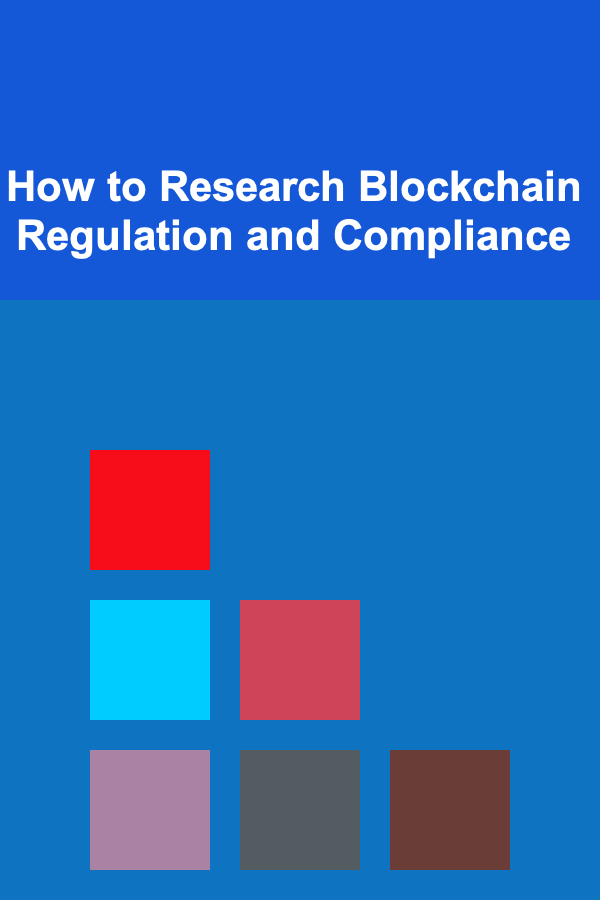
How to Research Blockchain Regulation and Compliance
ebook include PDF & Audio bundle (Micro Guide)
$12.99$5.99
Limited Time Offer! Order within the next:

The blockchain landscape is rapidly evolving, bringing with it innovative technologies and use cases across various industries. However, this rapid evolution presents a significant challenge: the regulatory environment is often playing catch-up. Navigating blockchain regulation and compliance requires a comprehensive and proactive approach. This article provides an in-depth guide on how to effectively research and understand the complex legal landscape surrounding blockchain technology.
Understanding the Scope of the Challenge
Before diving into research methodologies, it's crucial to understand the breadth of the regulatory challenge. Blockchain is not a monolithic entity. It encompasses various applications, including cryptocurrencies, smart contracts, decentralized finance (DeFi), supply chain management, and digital identity solutions. Each application faces unique regulatory considerations.
The core issues stem from:
- Jurisdictional Ambiguity: Blockchain is inherently global, while regulations are primarily territorial. Determining which jurisdiction's laws apply can be complex, especially when nodes and users are spread across multiple countries.
- Lack of Clarity: Many jurisdictions are still grappling with how to classify blockchain-based assets and activities. Are cryptocurrencies securities, commodities, or something else entirely? The answer varies by jurisdiction and asset type.
- Evolving Regulations: The regulatory landscape is constantly changing. New laws, interpretations, and enforcement actions are emerging regularly, requiring continuous monitoring.
- Technical Complexity: Regulators often lack the technical expertise to fully understand the nuances of blockchain technology, leading to potential misunderstandings and ineffective regulations.
- Decentralization: The decentralized nature of blockchain makes it difficult to identify responsible parties and enforce regulations.
Therefore, effective research must consider these challenges and adopt a multifaceted approach.
Step 1: Identifying Applicable Jurisdictions
The first step is to determine which jurisdictions are relevant to your blockchain project. This depends on several factors, including:
- Location of Development Team: The jurisdiction where the core development team is based is a primary factor.
- Location of Servers/Nodes: Where the nodes supporting the blockchain network are located can have regulatory implications.
- Location of Users: If your blockchain application targets users in specific countries, you must comply with their regulations.
- Where the Company is Registered: The place of incorporation or business registration is a key determinant of regulatory obligations.
- Currency/Token Listing: If your cryptocurrency or token is listed on exchanges in certain jurisdictions, you must comply with those exchanges' and countries' regulatory requirements.
Once you've identified the relevant jurisdictions, you can begin researching their specific regulations.
Step 2: Researching Regulatory Frameworks
This is the most crucial and time-consuming step. It involves gathering information from various sources and analyzing it to understand the regulatory landscape in each jurisdiction.
A. Primary Sources
These are the official sources of law and regulation. Relying solely on secondary sources is dangerous; always refer back to the original legal text.
- Legislation: Search for relevant laws and statutes passed by national or regional governments. Look for laws specifically addressing cryptocurrencies, digital assets, or blockchain technology. Examples include the EU's MiCA regulation (Markets in Crypto-Assets) or the numerous state-level regulations in the US. Use keyword searches on government websites.
- Regulations: These are rules and regulations promulgated by regulatory agencies to implement legislation. Examples include Securities and Exchange Commission (SEC) regulations in the US or Financial Conduct Authority (FCA) regulations in the UK. Access these through the agency's official website.
- Court Decisions: Court rulings interpreting laws and regulations provide valuable insights into how they are applied. Track relevant court cases in each jurisdiction, focusing on cases involving blockchain, cryptocurrencies, or digital assets. Services like Westlaw and LexisNexis are helpful, but often require subscriptions. Smaller jurisdictions may have publicly available databases of court decisions.
- Regulatory Guidance: Many regulatory agencies issue guidance documents, FAQs, and interpretive releases to clarify their position on specific issues. These documents provide valuable insights into how agencies interpret and enforce regulations. For example, the Financial Action Task Force (FATF) issues guidance on virtual assets and virtual asset service providers (VASPs).
Tip: When researching legislation and regulations, pay attention to definitions. The definitions of terms like "virtual asset," "digital asset," "security," and "financial instrument" can significantly impact how the law applies to your project.
B. Secondary Sources
These provide analysis, commentary, and summaries of primary sources. They can be helpful for getting an overview of the regulatory landscape, but should not be relied upon as the definitive source of information.
- Legal News and Publications: Stay up-to-date on legal developments by reading reputable legal news sources and publications specializing in blockchain and cryptocurrency law. Examples include CoinDesk, CoinTelegraph, Law360, and specialized legal blogs.
- Law Firm Publications: Many law firms publish articles, blog posts, and client alerts on blockchain regulation and compliance. These publications often provide valuable insights and analysis. Look for firms specializing in FinTech or blockchain law.
- Industry Associations: Join industry associations and participate in conferences and events to learn from other professionals and stay informed about regulatory developments. Examples include the Blockchain Association, the Digital Chamber of Commerce, and various local blockchain associations.
- Academic Research: Consult academic journals and research papers for in-depth analysis of legal and regulatory issues related to blockchain. Services like Google Scholar and SSRN can be useful.
- Consultants and Legal Counsel: Engage with legal counsel and compliance consultants who specialize in blockchain regulation. They can provide expert advice and guidance tailored to your specific project.
Tip: Be critical of secondary sources. Verify the accuracy of the information and consider the source's potential biases.
C. International Standards and Guidance
Beyond national regulations, international standards and guidance play a crucial role in shaping the global regulatory landscape. These guidelines often influence national regulators and provide a framework for international cooperation.
- Financial Action Task Force (FATF): FATF sets international standards for combating money laundering and terrorist financing. Its guidance on virtual assets and VASPs has been widely adopted by countries around the world.
- Basel Committee on Banking Supervision (BCBS): The BCBS sets standards for banking supervision. Its work on the prudential treatment of crypto-assets is relevant for financial institutions engaging with blockchain technology.
- International Organization for Standardization (ISO): ISO develops international standards for various industries, including blockchain. These standards can help promote interoperability and trust.
Tip: Familiarize yourself with the FATF's travel rule, which requires VASPs to collect and transmit information about the originator and beneficiary of virtual asset transfers.
Step 3: Analyzing and Interpreting Regulations
Once you've gathered the relevant information, you need to analyze and interpret it to understand its implications for your project. This involves:
- Identifying Key Requirements: Determine the specific requirements that apply to your project, such as registration, licensing, KYC/AML compliance, data privacy, and consumer protection.
- Understanding the Scope of Applicability: Carefully analyze the definitions and scope provisions of the regulations to determine whether they apply to your specific activities.
- Assessing the Level of Risk: Evaluate the potential risks associated with non-compliance, such as fines, legal action, and reputational damage.
- Seeking Legal Advice: Consult with legal counsel to obtain expert guidance on interpreting the regulations and ensuring compliance.
Tip: Don't assume that similar regulations in different jurisdictions have the same meaning. Always carefully analyze the specific language and context of each regulation.
Step 4: Monitoring Regulatory Developments
The regulatory landscape for blockchain is constantly evolving. It's essential to continuously monitor regulatory developments to stay informed and adapt your compliance strategies accordingly.
- Subscribe to Regulatory Updates: Sign up for email alerts and newsletters from regulatory agencies, law firms, and industry associations to receive updates on new laws, regulations, and guidance.
- Follow Regulatory Agencies on Social Media: Many regulatory agencies use social media to communicate with the public and announce important updates.
- Attend Industry Events: Attend conferences, webinars, and workshops to learn from experts and network with other professionals in the blockchain space.
- Regularly Review Research: Dedicate time on a regular basis (weekly, bi-weekly, or monthly) to revisit primary and secondary sources to ensure your information is current. Set reminders in your calendar.
Tip: Create a regulatory tracker to monitor relevant regulations and their status. Include information such as the date of enactment, effective date, and any amendments or updates.
Step 5: Building a Compliance Framework
Based on your research and analysis, develop a comprehensive compliance framework that addresses all applicable regulatory requirements. This framework should include:
- Policies and Procedures: Develop written policies and procedures to guide your activities and ensure compliance with regulations.
- KYC/AML Program: Implement a robust KYC/AML program to verify the identity of your customers and prevent money laundering and terrorist financing.
- Data Privacy Program: Develop a data privacy program to protect the personal data of your users in compliance with applicable data privacy laws.
- Training Program: Provide regular training to your employees on blockchain regulation and compliance.
- Monitoring and Auditing: Implement a system for monitoring your compliance efforts and conducting regular audits to identify any weaknesses or gaps.
Tip: Document all your compliance efforts and maintain records of all relevant activities. This documentation will be essential in the event of a regulatory audit or investigation.
Specific Areas of Regulatory Focus
While a broad approach is necessary, certain regulatory areas deserve particular attention:
A. Securities Laws
The application of securities laws to cryptocurrencies and other digital assets is a major area of regulatory scrutiny. Regulators in many jurisdictions are taking the position that certain cryptocurrencies and tokens are securities and must comply with securities laws, including registration requirements and disclosure obligations. The "Howey Test" in the US is frequently used to determine if an offering constitutes an investment contract and therefore a security. Understanding this test and similar concepts in other jurisdictions is crucial.
Research should include:
- Understanding the criteria used to determine whether a digital asset is considered a security in each jurisdiction.
- Analyzing the potential implications of being classified as a security, such as registration requirements, disclosure obligations, and restrictions on trading.
- Exploring potential exemptions from securities laws, such as private placements or offerings to accredited investors.
B. Anti-Money Laundering (AML) and Know Your Customer (KYC) Regulations
AML/KYC regulations are designed to prevent the use of financial systems for money laundering and terrorist financing. Blockchain companies, particularly VASPs, are subject to increasingly stringent AML/KYC requirements. As mentioned, understanding the FATF guidelines is critical.
Research should include:
- Understanding the KYC/AML requirements for VASPs in each jurisdiction, including customer due diligence, transaction monitoring, and reporting obligations.
- Implementing robust KYC/AML procedures to verify the identity of customers and prevent illicit activities.
- Staying up-to-date on the latest AML/KYC regulations and guidance.
C. Data Privacy Laws
Data privacy laws, such as the General Data Protection Regulation (GDPR) in the EU and the California Consumer Privacy Act (CCPA) in the US, regulate the collection, use, and storage of personal data. Blockchain companies must comply with these laws when processing personal data.
Research should include:
- Understanding the data privacy requirements in each jurisdiction, including data minimization, purpose limitation, and data security.
- Implementing appropriate data privacy policies and procedures to protect the personal data of users.
- Obtaining consent from users before collecting and processing their personal data.
D. Taxation
The tax treatment of cryptocurrencies and other digital assets is still evolving. Many jurisdictions are developing specific rules for taxing cryptocurrency transactions and holdings.
Research should include:
- Understanding the tax implications of buying, selling, and holding cryptocurrencies in each jurisdiction.
- Determining whether cryptocurrencies are treated as property, currency, or something else for tax purposes.
- Implementing appropriate tax reporting procedures to comply with tax laws.
E. Consumer Protection Laws
Consumer protection laws are designed to protect consumers from unfair, deceptive, and abusive practices. Blockchain companies must comply with these laws when offering products and services to consumers.
Research should include:
- Understanding the consumer protection laws in each jurisdiction, including requirements for clear and accurate disclosures, fair pricing, and dispute resolution.
- Avoiding misleading or deceptive marketing practices.
- Providing consumers with clear and understandable terms and conditions.
Emerging Trends and Future Considerations
The future of blockchain regulation is uncertain, but several trends are emerging:
- Increased Regulatory Scrutiny: Regulators are increasingly focused on blockchain and cryptocurrencies and are likely to step up their enforcement efforts.
- Harmonization of Regulations: There is a growing effort to harmonize regulations across jurisdictions to promote interoperability and reduce regulatory arbitrage.
- Development of Sandbox Environments: Many jurisdictions are creating regulatory sandbox environments to allow blockchain companies to test new products and services in a controlled environment.
- Focus on DeFi Regulation: Decentralized finance (DeFi) is attracting increasing regulatory attention, with regulators exploring how to regulate DeFi protocols and platforms.
- Regulation of NFTs: Non-fungible tokens (NFTs) are also coming under regulatory scrutiny, particularly in relation to intellectual property rights and securities laws.
Conclusion
Researching blockchain regulation and compliance is a complex and ongoing process. By following the steps outlined in this article, you can develop a comprehensive understanding of the legal landscape and build a robust compliance framework that will help you navigate the regulatory challenges and mitigate the risks associated with blockchain technology.
Remember that this information is for general guidance only and does not constitute legal advice. It is essential to consult with legal counsel and compliance professionals to obtain specific advice tailored to your particular situation.

How to Avoid Common Budgeting Mistakes While Managing Home Expenses
Read More
How to Plan a Party for a Special Occasion Without Stress
Read More
How to Soundproof Your Home's Floorboards for Less Noise
Read More
Innovative Solutions for the Modern Librarian: Enhancing Collection Development and User Experience
Read More
Mastering Time Management for Work-Life Balance
Read More
How To Sketch Food and Culinary Art: A Comprehensive Guide
Read MoreOther Products

How to Avoid Common Budgeting Mistakes While Managing Home Expenses
Read More
How to Plan a Party for a Special Occasion Without Stress
Read More
How to Soundproof Your Home's Floorboards for Less Noise
Read More
Innovative Solutions for the Modern Librarian: Enhancing Collection Development and User Experience
Read More
Mastering Time Management for Work-Life Balance
Read More